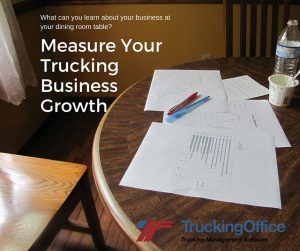Back on Leap Day, we posted a suggestion to you to set some goals for your trucking business this year. Then we blogged about the SCHEMES action plan method to help you move toward your goals. We even suggested fuzzy dice as a way to keep focus on your goals.
If you’re trying to grow your trucking business, setting goals can help you because it won’t be left to chance if you’re paying attention to what you want to achieve. A dozen different quotations on success and measurement from various people over time come down to one specific point:
If you can’t measure it, you can’t improve it.
So how do you measure your trucking business growth?
A simple way to measure your improvement is to look at how much you billed last month. That’s pretty simple information for you to find and examine. Comparing May to June is a good measure. The two months have roughly the same weather, same seasonal items, same economy. But if you were to compare June to November, can you get a good sense of how you’re doing? Invoices are an indicator of earnings, but is that the best number to use to determine profit?
Not at all.
There are too many expenses that have to be considered. A trip that looks highly profitable may lose its apparent value when you consider the expenses that you had to pay for the trip. Let’s compare one week’s trips. Which one do you think is a better deal?
Option 1 |
Option 2 |
| 1 load from Ohio to Texas, $3,000
1 load from Texas to Ohio, $1,500
|
1 load from Ohio to Indiana, $600
1 load from Indiana to Ohio, $800 3 times in one week
|
The only way you’ll know is if you have more data. You need to drill down and find out what’s what. How can you do that?
Using Graphs
In manufacturing, there are a series of equations to determine how a company is doing. These can all be done by computer, but many small business owners have preferred to do them by hand because the process shows the strengths and weaknesses of the business. Using graphs can do the same thing. You won’t even need a spreadsheet if you’ve got a piece of graph paper, but TruckingOffice will export to an Excel or Google spreadsheet.
In TruckingOffice trucking management software, you can find several key numbers by running the Company Overview Report.
By looking at a graph of these numbers, you might notice that there were a couple of months with a lot of loads (therefore a lot of invoices.) That should be good, right? But when you follow over to the Profit Per Loaded Mile column, those months don’t look at good. Hauling 54 loads but only making 33 cents per mile is a pretty busy month for not a lot of money to show for it.
What’s this all got to do with Goal Setting?
What you measure, you can improve. That busy month with the poor return is worth some analysis. Why was it so busy? Was I taking a bunch of short trips with low payoff? Was the economy bad that month? How did I do the previous year at the same time? When I have the answers to those questions, then I can make smarter decisions about loads in the future. I can figure out what’s driving down my profits – too many deadhead miles? – too many short trips that maybe should have been turned down or combined into LTL? A graph shows you the facts in an easy to read format just like a map is a lot easier to read than a list of directions. It shows you the questions you need to ask and answer to do better.
Now you can set new goals for next month – goals that will lead to your ultimate annual goal.








Recent Comments